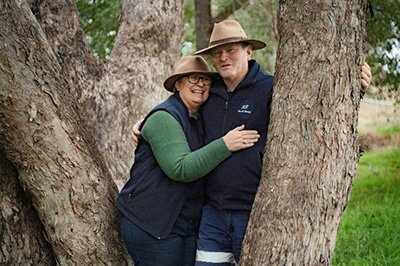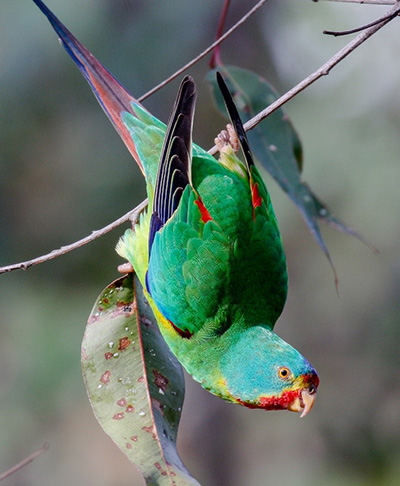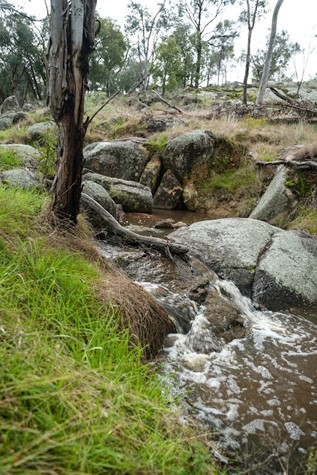Case study: Securing the Swift Parrot – Therese and Kevin Welsh
Introduction
Before Kevin and Therese Welsh submitted an expression of interest after reading about the Swift Parrot in their Local Land Services newsletter, they had never heard of the critically endangered Swift Parrot. Fast forward two years and the Welsh’s have turned one of their creeks on their property “Round Range” near Eugowra in Central West NSW into an ecological haven for the Swift Parrot and other native plant and animal species.

Therese and Kevin Welsh, “Round Range” Eugowra.
Kevin and Therese could not have imagined that when struggling with finances and mental health issues coming out of the most recent drought, that they would be in a position to help a critically endangered species and many other plants and animals. They have been able to create lasting practice change on their property that has had many positive knock-on effects.
Developing a holistic approach
The key challenge at “Round Range” was to find resources, funding and advice to develop a holistic approach to the water issues on farm including:
- including eroding banks
- lack of riparian vegetation and
- intermittent water availability for stock.
Historically, ‘Hell Hole’ creek on “Round Range” was heavily relied upon as drinking water for the stock. The Welsh’s had funded a complete off-creek watering infrastructure program on their property, delivering drinking water from the creek to their stock via troughs. However, coming out of the drought, Kevin and Therese realised that significant fencing along the creek area would be required to restrict grazing livestock to fully allow their creek line to rejuvenate and create lasting change.
The Welsh’s were planning to future proof themselves for the next dry period and were looking at funding opportunities to do so. They were curious when they saw a message in the Central West Local Land Services newsletter calling for expressions of interest from landholders to be a part of a funded habitat protection program in their region. Kevin and Therese knew they had several listed endangered plant species on their property and the thought of being part of a funded project that would not only help protect native plants but birds such as the critically endangered Swift Parrot was very appealing. The creek would be protected and this was the priority.
“We were still coming out of drought, so we just didn't have the cash flow. What we needed to do was slow the flow of the water so we can keep the water back in the landscape longer,” said Therese.
“We didn’t have the money to do so the opportunity in the Local Land Services newsletter was timely. We submitted an expression of interest knowing that we had white box, she oaks, ironbark and wattle species across this area. If we fitted the criteria, it as a perfect opportunity because we'll be supported and educated,” she said.

Swift Parrot (Mick Roderick - Birldife Australia).
Working with Local Land Services to enhance the landscape
The works undertaken by Kevin and Therese with Central West Local Land Services included:
- surveying the project area
- researching
- plant identification and
- planning where to fence based on Local Land Services guidelines
The Welsh’s received incentive funding for fencing, pest animal and pest weed control and provision of suitable native species that would enhance the area. The fencing was done by local fencing contractors and family members and with the wetter than usual conditions took 8months to complete. Once the fence was completed and secure from stock approximately 250 native upper and mid storey species were planted and guarded. The planting success rate has been excellent.
“It's a ten year program that we could see into the future, we just had to put in some of our own labour towards doing the work,” Therese said.
“The big expense was getting the fencing done, and now with permanent fencing and stock exclusion we can see the results already in this short time of two years.”
Protecting the Swift Parrot
The Central West Local Land Services region contains important habitat for the critically endangered Swift Parrot.
This bird had previously occupied much of the eastern woodlands of Australia but has drastically declined in numbers. These birds breed exclusively in Tasmania then head across Bass Strait in one flight to the mainland through the cooler months to feed on the seeds and nectar of flowering trees and mistletoes.
The Securing the Swift Parrot Project aims to increase community awareness about the species, monitor areas of known and potential habitat and carry out on ground works to preserve and restore habitat and corridors in priority areas.
Ongoing protection, management and recovery of remnant vegetation on private land is crucial to the future survival of this unique species. Priority areas have been identified across the Central West region with recommended activities to support and increase the connectivity and condition of significant habitat. There is a particular focus on projects that occur in areas with mature Grey Box, White Box, Yellow Box and Mugga Ironbark woodlands as these species provide a critical food source for migrating birds.
“Local Land Services were always at the end of the phone,” Therese said.
“We've fenced off 16 hectares and planted over 300 trees and change is happening.
“Water is pooling. The ground is producing trees and habitat that we don't have to plant and the birdlife is abundant. I've noticed birds I've never seen before,” she said.
Results, growth and positive long term effects
No grazing has taken place in the fenced creek area for 2 years with very good seasons, it has regenerated the site beyond recognition. As well as creating a prime habitat for the Swift Parrot and other birdlife, the Welsh’s have seen widespread positive knock-on effects to the ecosystem of the property as a whole.
The Welsh’s documented massively increased biodiversity including more than twenty different plant species that were not previously present. The Swift Parrot project at “Round Range” exemplifies how making some relatively small changes to a large ecosystem can go a long way to protecting an endangered species and have overwhelmingly positive and long-lasting flow on effects across the property.
“We know we're only guardians and we are protecting this landscape for the future. Protecting the Australian landscape is what has been happening for tens of thousands of years, and with that we feel very privileged to be in this space,” Therese said.

Creek on the Welsh's creek.
Hear from Therese and Kevin Walsh
Funded by
This project is supported by Local Land Services, through funding from the Australian Government’s National Landcare Program.
For more information
Contact your nearest Local Land Services office on 1300 795 299.